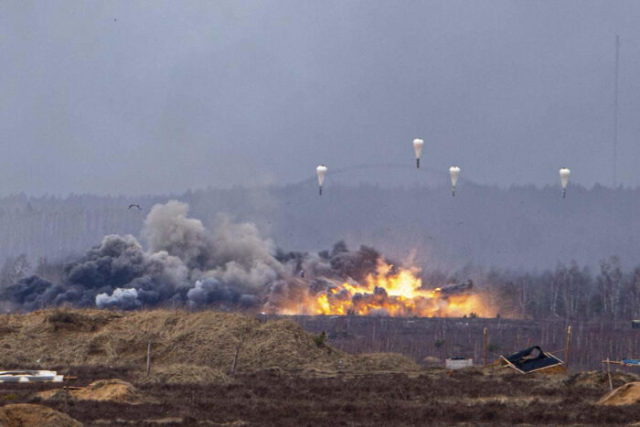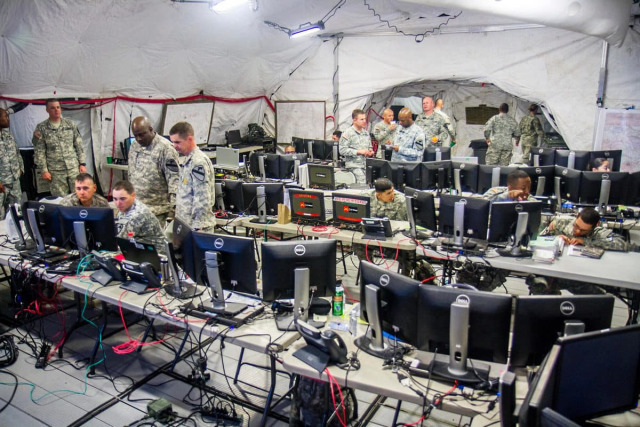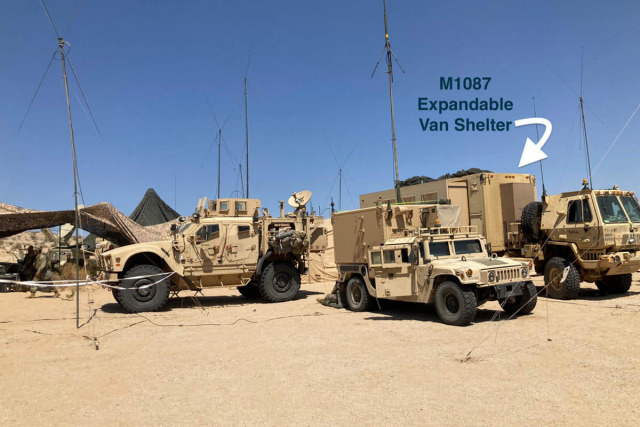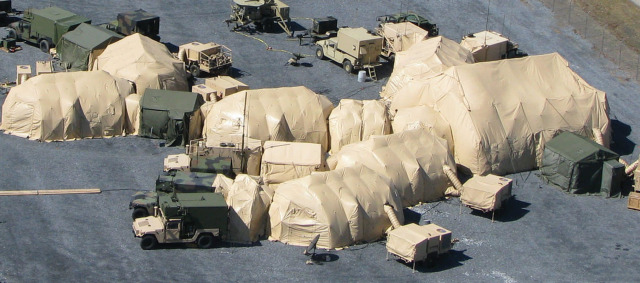Almost every day in the news about the fighting in Ukraine, it is reported about the discovery and destruction of a Ukrainian or Russian tactical command post (KP). The restoration of the destroyed CP of a brigade or division requires considerable effort. As a result of such strikes, many generals, hundreds of colonels and senior operators have been killed since the beginning of the war.
According to NATO experts, like the Russians and Ukrainians in the current conflict, the alliance cannot afford to lose tactical KP. The configuration of the Russian KP at the beginning of the conflict did not differ much from the NATO KP. Based on the lessons of the conflict, it is vital to rethink how modern armed forces prepare their control nodes for combat.

Attack of the AFU positions in Ukraine
As stated by the authors of the article "Graveyard of Command Posts" (The Graveyard of Command Posts), published in March 2023 in the "Military Review of the US Army" (Army's Military Review): "We need to rethink command posts for this new era of warfare. In the face of this immediate threat ... command posts will have to adapt to such an extent that they will be unrecognizable to a generation of leaders who fought in Iraq and Afghanistan."
According to the conclusion of military experts, NATO tactical command posts in the form in which they are currently equipped and operated are not ready for battle and will not survive the first strike in the next war. The lessons of three recent wars, the second war in Nagorno–Karabakh (2020), Israel's war with Hamas (2021) and the ongoing Russian-Ukrainian war (since February 2022), demonstrate that KP are valuable targets and are at great risk in the modern combat space.
These recent conflicts are the future of military operations: The second Nagorno-Karabakh War in 2020 was the first conflict in history won mainly through the mass use of robotic systems; the war of the Israel Defense Forces (IDF) with Hamas in 2021 was the first won mainly with the help of artificial intelligence; and the Russian–Ukrainian war is the largest conflict in Europe since 1945 years with the use of perhaps the widest range of military technologies in history.
The main conclusion that Western experts make is that the destruction of command and control is the essence of the war of the 21st century. Today, KP is almost impossible to hide and extremely difficult to protect. Searching and pointing at the KP is at the top of the enemy's to-do list. Currently, the preparation of survivable tactical KP configurations and their equipment for victory should become a priority.
On the way to a transparent combat space
In the past, the enemy had to be seen and heard with human eyes and ears, as well as displayed using analog maps and terrain models. It was especially difficult at night and in extreme weather. The victorious armies resorted to unusual means of disguising their locations. In addition to low visibility at night, they used environmental conditions, including storms and fog, as well as opaque terrain such as forests, mountains and urban development. Knowing what was behind the next hill or around the corner in an urban setting required reconnaissance conducted by personnel.
Today, sensors are rapidly expanding, and in some areas replaces similar forms of intelligence. Multi-domain (multi-sphere) sensory capabilities, which even third-level armies now possess, have made it much more difficult to hide on the battlefield. Multi-domain sensor networks use technology capable of scanning space down to dirt at the level of the earth's surface to identify targets.
It is not easy to create an unblinking eye that identifies, finds and tracks targets in an overloaded combat space. It takes complex planning and systems to identify the enemy, but it gives an advantage in battle and is worth the investment. When ubiquitous sensors are combined with high-precision long-range fire capable of hitting and destroying targets at extreme distances, staying alive on the modern battlefield becomes a difficult task.
In Nagorno-Karabakh in 2020, in Gaza in 2021 and in Ukraine since 2022, the combined efforts of sensors, unmanned aerial vehicles (UAVs) and long-range precision fire have determined the course of these conflicts. To see the enemy's forces in combat space and be able to strike at them almost anywhere is a revolutionary revolution in traditional methods of warfare. The combat space becomes more transparent – the sensor layer can transmit information in real time to show the combat space and confirm combat damage, exposing each military point to potential risk.
The chairman of the Joint Chiefs of Staff of the US Armed Forces, General Mark MILLEY, said: "The probability of being noticed is very high. On the battlefield of the future, if you stay in one place for more than two or three hours, you will be dead." With the rapid development of sensor technology, even two or three hours can be optimistic. It is believed that Western military thinking should be based on the concept that safe areas no longer exist, and troops are most likely in range of enemy fire. Anything less entails disaster.
Tactically, command posts: rethinking
According to Western military theory, command and control (C2) of the armed forces and mission management is the most important function of warfare. The purpose of the KP is to help the commander in the performance of a combat mission [in Western terminology, Mission Command (MC), hereinafter referred to as KM]. KM argues that human decision-making ‘at the point of contact’ generates a flexible and winning approach that promotes harmony, initiative and speed by understanding the commander's intentions, following orders by type of mission and giving lower-level initiative. The tactical command post makes it easier for the commander to perform KM, allowing him to better understand, imagine, describe, direct and evaluate combat operations.

Command post in paldatka
Large command posts in tents, as shown in the photo, are a tempting target. If a barrage of ammunition gets into this KP, the assembled command and staff brain of an entire armored division will be lost. The US Army believes that it is necessary to rethink the training and deployment of KP, and practice "distributed mission command".
For decades, tactical command posts were housed in tents and vans, some of which were complex enough to accommodate dozens of operators with computers, large screens and other auxiliary equipment. Today, concentrating critical human resources in one place, within range of enemy sensors and fire, is a sure path to disaster.
Tents do not provide protection from UAVs or artillery strikes. Modern alternatives, including CP trailers called "expandable vans," such as the US Army M1087 expandable shelter van, are not much better. Although these vehicles provide easier CP training, they are not truly mobile combat control points, since personnel cannot control while inside when the CP themselves are on the move. These shelters can be moved, which means that it takes time to install, deploy, and then move them. During an attack by UAVs, artillery or missiles, they provide weak protection.
To increase survivability in a modern combat space, KP must be armored, mobile, camouflaged and dispersed. This is not a traditional representation of KP, but the harsh reality of modern combat. One should not hesitate to quickly determine the basic design parameters that will prepare a modern KP to meet these requirements.
Booking. During the second Nagorno-Karabakh War, Azerbaijan destroyed Armenian tactical command posts in the first weeks of the fighting, as they were easily detected and housed mainly in tents and unfinished structures. During the war between Israel and Hamas, the IDF tracked the location of Hamas leaders and synchronized its attacks using sophisticated artificial intelligence. During the Russian–Ukrainian war, many military command posts were destroyed by high-precision long-range weapons.
A logical alternative to a KP with a "soft" cover is the maximum use of available armored vehicles to protect against enemy fire. Any armored vehicle equipped with the necessary equipment for command, control, communications, computers, intelligence, surveillance and reconnaissance (C4ISR) is far superior to a tent or a tactical vehicle with a soft skin. The formation of a mesh network of mobile armored checkpoints complicates the tasks of reconnaissance and targeting of the enemy. Each unit of armored vehicles must be equipped with C4ISR systems necessary to independently take over combat control.
In 1982, U.S. Army General Donn A. STURRY said: "... experience has convinced us that a corps battle cannot be fought from the main command post, and we believe that the evidence is sufficiently convincing for us to place an armored TAC CP [tactical command post/TCP] with sufficient equipment and personnel to track the battle and issue timely orders." According to modern analysts, the general's insight was correct then and is more relevant today, especially in the fight "with an almost equal opponent." The armed forces are required to either adopt armored vehicles for KP or occupy fortified urban facilities, or "dig in" deeply and quickly.
Mobility. Military personnel can no longer stay in any position for a long time. Although most modern CP solutions are suitable for moving, they require too much time for deployment and folding, and cannot work on the go. A mobile CP that can move in an instant will reduce vulnerability to enemy fire. In a transparent combat space, only mobile and protected KP will survive, capable of implementing mobile command (MC) in motion, which increases the survivability of KP. MK allows commanders to be closer to the front line, with a smaller tactical footprint and with a higher chance of survival. Tactical command posts must have the ability to function on the go and constantly practice this skill.

"Extended" van-shelter as part of the CP of the US Army
Since September 2022, the Tactical Operations Center of the Armored Brigade Combat Team (ABCT) has been operating at the Fort Irwin National Training Center (California). For use as a KP, ABCT has "expandable" M1087 shelter vans. These vans are easier to install than tents, but they do not provide the necessary protection. According to the conclusion of US military analysts, the command of a brigade in vans similar to these is an extremely vulnerable target in a transparent combat space.
Disguise. In order to survive in a transparent combat space, KP must disguise themselves. Masking requires a full range of multi-domain efforts to deceive enemy sensors and disrupt enemy targeting. KP require equipment, as well as tactics, methods and procedures for optical (to be the best in physical masking), thermal (to reduce thermal signatures), electronic (to reduce emissions and control electronic signatures) and acoustic (to muffle sounds) masking.
In order to deceive the sensors of the enemy KP, false positive signals should also be generated using decoys and avoiding obvious congestion of vehicles. A group of three or four vehicles looks like a platoon for most sensors, and there will be many platoons in the combat space, which will significantly complicate identification and targeting. On the other hand, eight or more vehicles represent a much more recognizable and therefore tempting target. Thus, to form the cellular structure of the KP, it is proposed to combine groups of 2-4 vehicles into MK nodes.
Dispersal. The configuration of tactical command posts with high survivability requires a new approach to how KP work, communicate and exchange information in the combat space. It is proposed to avoid the concentration of equipment and operators in places where it is easy to find and destroy targets. For example, a battalion-level KP network configuration could consist of three distributed nodes, two armored vehicles equipped with C4ISR for each node, dispersed according to the terrain and threat and using a single operational picture to track and synchronize the battle. Such a network arrangement will become stable when each node is ready to take command as needed.
It is argued that the ideal network configuration of the KP is a flexible, self–forming, self-repairing and self-organizing tactical network arrangement of command nodes. The network configuration of the KP distributes the combat control infrastructure into stable "functional nodes" that are scattered and camouflaged throughout the battlefield, but at the same time maintain effective communication. Such a "distributed mission command" uses smaller, dispersed combat control nodes to perform KP functions without co-locating personnel. The goal is to increase the continuity and survivability of command functions in the modern combat space.
Visualizing the future
According to the conclusion of Western military experts, the only constant in leadership and war is change. Commanders need foresight to imagine and prepare for the next battle. The systematic autopsy and attack of KP in recent conflicts is a wake–up call. If it is possible to change the current views on the KP and organize them around a distributed mission command, using the military Internet cloud and hardware, it will be possible to perform combat control functions and provide a permanent MC as a service, rather than a geographical location.
If we imagine that the KP was created in the form of a mesh network of command nodes, each of which includes 2-4 armored personnel carriers networked. This would allow any commander, from battalion to corps, to operate from any of the nodes. The commander moves from node to node, which enhances his presence and leadership. If one node is hit, another takes its place, and the new acting commander freely takes command of the unit.
To avoid turning KP into a graveyard, commanders should rethink how MK is conducted and adopt a new set of tactics, methods and procedures for KP. As General James McConville, chief of staff of the US Army, said in October 2022: "In the future, the battlefield will be so deadly, and it will be possible to collect information about where our command posts are, so we will have to move them very, very quickly, and they should be dispersed and smaller."
The lesson of the second Nagorno-Karabakh war, Israel's war with Hamas and the Russian–Ukrainian war is clear: in a modern, transparent, deadly combat space, the target that has revealed itself is being hit. The lack of foresight in the preparation of control points will lead to the fact that they will be quickly opened and destroyed, which will lead to an irreparable loss of experienced commanders and personnel. Despite many discussions about equipping KP for modern combat operations, not enough is being done to deploy new systems and train command and staff groups. Preparing tactical command posts for the next war is a vital task that requires immediate action.
Based on the materials of the resource euro-sd.com

